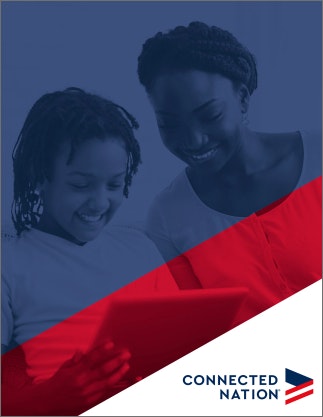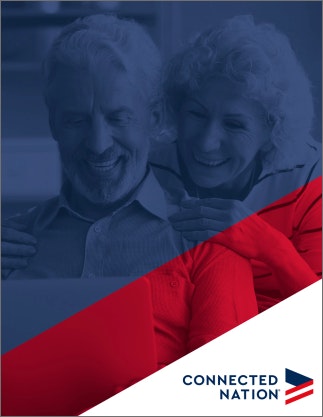Overview
The Wilbarger County Broadband Team has completed its community technology assessment. The results of the assessment can be found by clicking the symbol for each of the sections below. The Recommended Actions section includes steps the community can implement to improve the broadband and technology ecosystem at a local level.
It should be noted that the assessment was conducted during the global COVID-19 pandemic. This worldwide event likely impacted many of the metrics included in this assessment.
INFRASTRUCTURE
Connected Infrastructure in Wilbarger County, Texas
Broadband access refers to the infrastructure that enables a high-speed internet connection. There are two primary types of broadband connections: fixed and mobile.
Fixed broadband is delivered to a user via several technology platforms including cable, digital subscriber line (DSL) over phone lines, fiber optics, and fixed wireless. Fixed broadband is designed for stationary use at a fixed location such as a home, business, or institution. From one location, however, fixed broadband service is often broadcast as a Wi-Fi network to connect nearby devices.
The following map shows where broadband is available in the community.
Recommended Actions
Objective: Ensure all residents have access to the internet and speeds that meet their needs for work, education, telehealth, and quality of life purposes.
Texas was allocated $3.3 billion under the Infrastructure Investment and Jobs Act (IIJA) via the Broadband, Equity, Access, and Deployment (BEAD) program and $55 million under the Digital Equity Act (DEA). These programs will fund projects that help expand high-speed internet access and ensure Texas communities have the information technology capacity needed for full participation in society, democracy, and economy by promoting diverse digital advancement projects. This federal funding opportunity is a once-in-a-generation infusion of money administered by the Texas Broadband Development Office (BDO) to eligible entities via a competitive grant program. As this is a generational funding opportunity, Wilbarger County should track broadband developments at the state and federal levels to ensure community needs are met in a timely manner.
Action 1 – Establish and maintain open communication and positive relations with internet service providers (ISPs) working or scheduled to work in the county, as well as ISPs interested in expanding in the county.
ISPs are key partners for communities looking to expand broadband access. Checking in regularly with ISPs allows community leaders to stay abreast of construction and expansion progress or plan changes, identify challenges they face, and communicate community goals and objectives. This open communication allows ISPs to better understand community needs and communities to better understand the obstacles and barriers that ISPs face. This understanding can encourage creative problem-solving, which can lead to finding solutions through public-private partnerships. Public-private partnerships are arrangements between public entities, such as local governments, and private entities, such as ISPs, to achieve a common goal. They are often, but not always, funding arrangements.
Additionally, the county should strive to be an environment amenable to business. This means having easy-to-use websites that allow ISPs and vendors quick access to relevant information, as well as fostering a business environment that rewards open communication and timely resolution of concerns. Fostering open communication with ISPs is critical for broadband development. As part of BEAD applications, ISPs must demonstrate local support. Relationships with local leaders will ensure successful grants and deployment according to county needs.
Action 2 – Pursue state and federal funding for broadband advancement.
As mentioned previously, the infusion of federal funds via BEAD and DEA into the state is an opportunity for Texas communities to support ISPs and other entities looking to expand infrastructure and programs that support robust broadband delivery. Wilbarger County should explore the best ways to support ISPs who are considering buildouts in the community. In addition, other funding sources, such as the U.S. Economic Development Association or the U.S. Department of Agriculture, promise opportunities for broadband. Funding guides have been linked in the resource section. Capitalizing on this once-in-a-generation funding opportunity will ensure Wilbarger County residents have faster, more reliable broadband for years to come.
Action 3 – Partner with local ISPs to promote low-cost broadband programs.
According to survey results in Wilbarger County, the average monthly cost of internet is $62.50. Feedback provided by the city of Vernon officials who spoke with CN Texas in May 2024 about the ongoing broadband assessment highlighted a cost barrier for many residents. City officials noted that many residents are on a fixed income, many due to their age and retirement status, which makes high monthly internet charges burdensome. As such, the county should work with community leaders and institutions to publicly promote programs and opportunities designed to reduce the cost of broadband service.
Below are some programs and resources that are available to residents.
· Resources to locate affordable internet service or computers: Using online resources, Wilbarger County residents can identify local and national providers who offer special low-cost services for vulnerable populations, older adults, and low-income families with children. Resources include EveryoneOn (https://www.everyoneon.org/), which helps residents locate low-cost internet services and affordable computers by ZIP code and by need based on their participation in assistance programs.
- State and federal low-cost programs:
- Lifeline is a federal program administered through the Federal Communication Commission (FCC) Universal Service Administrative Co. that lowers the monthly cost of phone or internet services for eligible consumers. Consumers can get up to $9.25 off the cost of phone, internet, or bundled services each month. Households can qualify based on income or participation in federal or Tribal assistance programs.
ISPs often offer consumers low-cost options or subsidized programs at a significantly reduced cost. The IIJA requires internet providers that receive federal grant money to provide low-cost services to eligible low-income households. Using Wilbarger County-specific data, local advocacy for internet affordability will ensure that residents can continue accessing online information and virtual resources.
Action 4 – Establish broadband leadership within the county.
In Connected communities, broadband affects many sectors across the county, from local government to health care, education, business, and agriculture. Coordinating all these sectors requires engagement and commitment from each. Wilbarger County should establish a broadband coalition with representation from key community anchor institutions, local businesses, and residents to create a coordinated response to broadband challenges and opportunities in the county. Broadband coalitions allow everyone to collaborate and share opportunities while avoiding duplication of services and resources.
Resources
- The FCC High-Cost program: CAF A-CAM
- The Rural Digital Opportunity Fund (RDOF)
- Coronavirus State and Local Fiscal Recovery Funds, Allocation by County
- ARPA SLFRF, Final Rule
- Broadband Development Office Funding Programs
- BroadbandUSA: Federal Funding Guide
- Guide to Federal Broadband Funding Opportunities in the U.S.
- Lifeline Program
Objective: Partner with libraries and community organizations to provide digital literacy training.
Broadband connects people to the world and opens the door to opportunity. Where there is broadband, there is development, achievement, and innovation. In rural communities, broadband looks like economic development, greater academic achievement, advancement in agriculture and farming, connection to telehealth services, infrastructure improvement, and general technological advancements. To engage online, an individual must have the digital skills to navigate the internet safely. Many local and national organizations offer digital training and literacy workshops to the public for free or at a reduced cost. Making these programs widely and frequently available throughout Wilbarger County will increase engagement, adoption, and internet use and open digital opportunities for all.
In May 2024, CN Texas hosted six digital skills workshops in partnership with the Carnegie City-County Library. Class topics included internet basics, computer basics, email basics, mobile device basics, introduction to videoconferencing, and internet safety (cybersecurity). Classes were free and open to the public. All participants received a certificate of completion at the end of each class. Additionally, all participants and host sites received a link to the online curriculum to continue digital learning. This engagement is a prime example of programming that community anchor institutions can offer to residents, often for free, in partnership with local and national organizations. Continuing this work is a priority for the library and should be supported by county leaders.
Action 1 – Develop a curriculum for free community workshops.
Community organizations should continue offering digital skills workshops in partnership with local and regional organizations. Classes can be provided at local facilities, such as the school gym, library, or community center, and be advertised through the local media. Classes should promote safe online activity and increase digital engagement. The more the community engages online, the more residents will reap the benefits of a digital lifestyle.
Workshop topics might include:
- How to teleconference
- Cybersecurity 101
- Microsoft Office skills
- Intro to social media and website building
- Telehealth basics
CN Texas provided the Carnegie City-County Library with curriculum and materials when it offered in-person training. This curriculum can be used as is or customized further to meet residents' needs.
Action 1A – Provide varied formats for greater community involvement.
In addition to hosting in-person workshops, the general curriculum should be available for pickup at frequently accessed public locations in the form of paper handouts. Handouts function as a “grab and go” resource for residents to take with them to review later. In this way, everyone can benefit from the content in whatever way is most compatible with their schedule and preferred learning method. Additionally, the library and other city and county websites can promote online learning platforms that teach digital skills.
Action 2 – Partner with community stakeholders for workshop execution.
Finding broadband champions who can share the impact of technology from their perspective can help class participants understand the broad impacts of connectivity. Industry leaders can speak to the importance of broadband in their respective lines of work. For example, a banker can discuss the benefits of online banking, while the school IT Director can discuss the importance of online safety. Building on local expertise will help drive workshop attendance and meet the unique needs of Wilbarger County residents. When county leaders understand their audience, they can invite guest speakers, select a specific curriculum, and pick class times/locations that are most convenient for the end user, which will promote greater engagement.
Resources
Digital Literacy
- Connected Nation Digital Literacy Workshops
- Digital Learn – Free courses to learn anything about computers
- Digital Literacy Curriculum for K-12
- Free Applied Digital Skills – Google for Education
- Live, Virtual Classes for Seniors
- AARP joins nonprofit to teach tech to older adults
- The complete guide to digital skills
- Grow with Google
Cybersecurity
Objective: Bring additional resources to Wilbarger County to support residents’ adoption and use of the internet.
Broadband connects people to the world and opens the door to opportunity. Where there is broadband, there is development at the individual and community level.
Action 1 – Pursue grants to advance local community development using broadband technologies (e.g., workforce development, telehealth, digital literacy, etc.).
State and federal agencies focus on broadband access and adoption, providing significant funding to increase broadband availability and close the Digital Divide. Additionally, many Texas and national philanthropic organizations support this work. Wilbarger County should evaluate these grant programs and make strategic decisions to apply for funding to advance broadband access, adoption, and use in the county.
Wilbarger County has been allocated grant writing funds in conjunction with the countywide Connected Engagement program. The goals and actions outlined in this document provide the framework for county leaders to prepare for and pursue applicable funding opportunities and program advancements designed to close the Digital Divide in Wilbarger County.
Through countywide partnerships and collaborative efforts, the community can advocate and provide equitable, affordable, and reliable broadband access for all residents, businesses, and community anchor institutions. Texas Rural Funders maintains an online hub of grant resources. The community should consider utilizing this resource to identify a funding program that best meets their needs.
Resources









